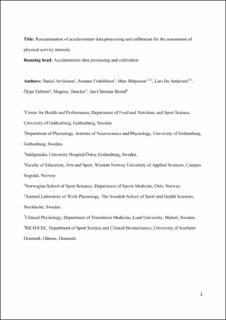Re-examination of accelerometer data processing and calibration for the assessment of physical activity intensity
Arvidsson, Daniel; Fridolfsson, Jonatan; Börjesson, Mats; Andersen, Lars Bo; Ekblom, Örjan; Dencker, Magnus; Brønd, Jan Christian
Peer reviewed, Journal article
Accepted version
Permanent lenke
https://hdl.handle.net/11250/2654008Utgivelsesdato
2019Metadata
Vis full innførselSamlinger
Originalversjon
Arvidsson, D., Fridolfsson, J., Börjesson, M., Andersen, L. B., Ekblom, Ö., Dencker, M., & Brønd, J. C. (2019). Re‐examination of accelerometer data processing and calibration for the assessment of physical activity intensity. Scandinavian Journal of Medicine & Science in Sports, 29(10), 1442-1452. 10.1111/sms.13470Sammendrag
This review re‐examines the use of accelerometer and oxygen uptake data for the assessment of activity intensity. Accelerometers capture mechanical work, while oxygen uptake captures the energy cost of this work. Frequency filtering needs to be considered when processing acceleration data. A too restrictive filter attenuates the acceleration signal for walking and, to a higher degree, for running. This measure-ment error affects shorter (children) more than taller (adults) individuals due to their higher movement frequency. Less restrictive filtering includes more movement‐re-lated signals and provides measures that better capture mechanical work, but may include more noise. An optimal filter cut‐point is determined where most relevant acceleration signals are included. Further, accelerometer placement affects what part of mechanical work being captured. While the waist placement captures total me-chanical work and therefore contributes to measures of activity intensity equivalent by age and stature, the thigh and wrist placements capture more internal work and do not provide equivalent measures. Value calibration of accelerometer measures is usually performed using measured oxygen uptake with the metabolic equivalent of task (MET) as reference measure of activity intensity. However, the use of MET is not stringent and is not a measure of activity intensity equivalent by age and stat-ure. A candidate measure is the mass‐specific net oxygen uptake, VO2net (VO2tot − VO2stand). To improve measurement of physical activity intensity using accel-erometers, research developments are suggested concerning the processing of ac-celerometer data, use of energy expenditure as reference for activity intensity, and calibration procedure with absolute versus relative intensity.
Beskrivelse
This is the peer reviewed version of the following article: Arvidsson, D., Fridolfsson, J., Börjesson, M., Andersen, L. B., Ekblom, Ö., Dencker, M., & Brønd, J. C. (2019). Re‐examination of accelerometer data processing and calibration for the assessment of physical activity intensity. Scandinavian Journal of Medicine & Science in Sports, 29(10), 1442-1452, which has been published in final form at https://doi.org/10.1111/sms.13470. This article may be used for non-commercial purposes in accordance with Wiley Terms and Conditions for Use of Self-Archived Versions.
